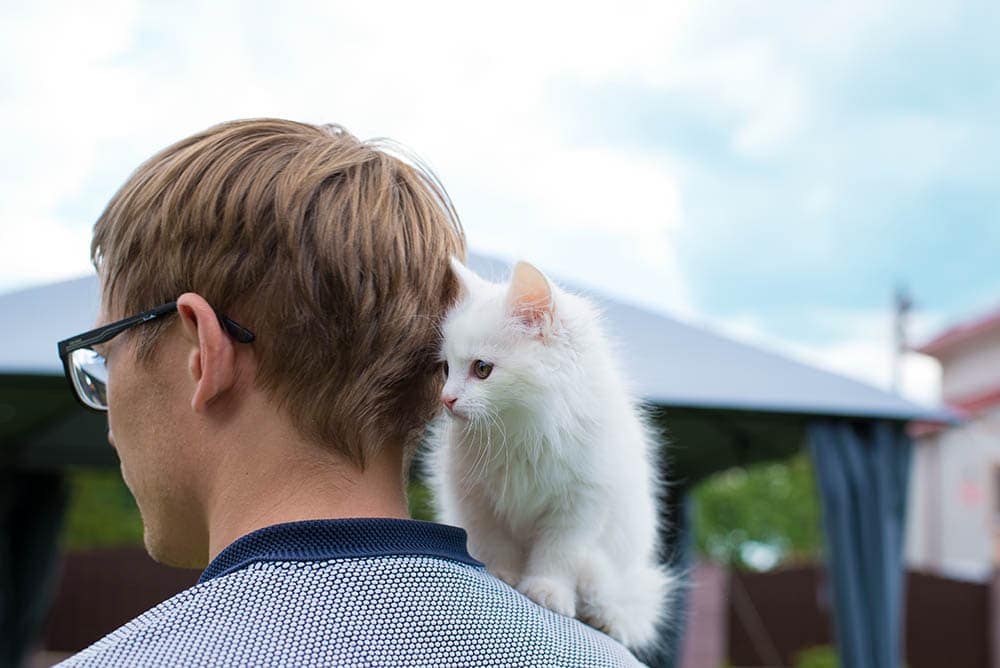How to Train a Cat to Sit on Your Shoulders

Cats are independent animals, but many love to snuggle and be close to their owners. Trying to train your cat to sit on your shoulders is not only a fun way to bond with your pet, but it can also be a practical solution for keeping your hands free while carrying your cat around.
In this article, we will discuss the benefits of shoulder training, how to prepare your cat for training, the best time and place to train, a step-by-step guide to the training process, common challenges and how to overcome them, tips for reinforcing training, safety precautions to keep in mind, frequently asked questions, and finally, enjoying the benefits of shoulder sitting with your pet cat.
Why Train Your Cat to Sit on Your Shoulders
There are many benefits for you to train your cat to sit on your shoulders. For one, it’s a great bonding experience between you and your pet. It can also be a practical solution if you need to carry your cat around with you, but want to keep your hands free. Additionally, cats are natural climbers, and they may enjoy the elevated view from your shoulders.
Another benefit of training your cat to sit on your shoulders is that it can help your cat feel more confident and secure. Your cat can feel more comfortable in unfamiliar or stressful situations by spending time close to you and being elevated.
Shoulder training can also provide mental and physical stimulation for your cat, as it requires them to use their muscles and balance to stay on your shoulders. Furthermore, it can be a fun and entertaining activity for both you and your cat, adding more variety to your daily routine.
Preparing Your Cat for Shoulder Training

Ensure that your cat is comfortable with being handled and is in good health before starting to train them to sit on your shoulders. Begin by picking up and holding your cat to get them used to it. Practice picking them up slowly and gently, and reward them with treats and praise when they remain calm. Make sure that your cat’s claws are trimmed to avoid any accidental scratches.
It’s also a good idea to get your cat used to being on elevated surfaces, such as a cat tree or a high shelf, as this will help prepare them for the feeling of being on your shoulders. You can encourage your cat to climb up by placing treats or toys on the elevated surface. Gradually increase the height of the surface to help build your cat’s confidence while rewarding them with treats to build positive associations with it.
Choosing the Right Time and Place to Train
When it comes to training your cat to sit on your shoulders, timing and location are important factors to consider. Choose a time when you notice your cat is relaxed and in a good mood, such as after a meal or playtime. Avoid trying to train your cat when they are feeling anxious or stressed.
The location you choose for training should also be comfortable and familiar to your cat. Start in a quiet room with minimal distractions, and gradually move to busier environments once your cat becomes more comfortable with shoulder sitting. It’s important to remember that every cat is unique, and some may take longer to adjust to new situations than others. Patience and positive reinforcement are key to successful shoulder training.
Step-by-Step Guide to Train Your Cat to Sit on Your Shoulders
Now that you have prepared your cat for the training and have chosen the right time and place to train. Here are the steps you can use to train your cat to sit on your shoulders:
Step 1: Familiarize your cat with your hand
Start by sitting down next to your cat and letting them smell your hand. Offer them a treat as a reward for sniffing and being near your hand. You can also try gently petting them with your hand while giving them a treat. This will help your cat associate your hand with positive experiences and build trust between you and your pet cat.
Another way to do this is by placing a treat in the palm of your hand and offering it to your cat to encourage them to approach and interact with you. Repeat these exercises daily until your cat is comfortable with your hand and readily approaches you for treats. Once your cat is comfortable with your hand, you can move on to the next step of the training process.
Step 2: Encourage your cat to climb on your hand
Once your cat is comfortable with your hand, the next step is to encourage them to climb onto it. Place your hand on a high surface like a table or countertop and use treats to coax your cat onto your hand. Provide positive reinforcement by offering them a treat every time they climb on your hand. Repeat this process until your cat becomes comfortable with climbing on and off your hand on command. This step is crucial in teaching your cat to sit on your shoulders as it helps to build trust and comfort.
Step 3: Move your hand closer to your shoulder
Now that your cat is comfortable climbing onto your hand, it’s time to move on to the next step of the training process. Start by gradually moving your hand closer to your shoulder while encouraging your cat to climb higher. Use treats as rewards to entice your cat to climb onto your shoulder.
Once your cat reaches your shoulder, reward them with a treat and praise. Gradually increase the duration your cat sits on your shoulder and offer plenty of positive reinforcement to encourage them to stay put. This step is essential in teaching your cat to sit on your shoulder for extended periods, as it helps them get comfortable with the position and learn to associate it with positive experiences.
Step 4: Get your cat used to sitting on your shoulder
Once your cat is comfortable with climbing onto your shoulder, it’s time to get them used to sitting on your shoulder. Gently hold your cat in place with one hand while offering treats with the other hand. This will help your cat associate sitting on your shoulder with positive reinforcement.
Start by allowing your cat to sit on your shoulder for a few seconds at a time, then gradually increase the amount of time they spend there. Be sure to offer plenty of praise and treats during this step to keep your cat motivated and comfortable.
It’s important to keep in mind that not all cats may enjoy sitting on shoulders, so pay attention to your cat’s body language and behavior. If your cat seems uncomfortable or stressed, stop the training and try again another time.
Step 5: Practice regularly
The key to success in training your cat to sit on your shoulder is consistency and regular practice. Make sure to repeat the training process several times a day and gradually increase the duration your cat spends on your shoulder.
You can also try different techniques to keep your cat engaged, such as offering them treats or toys to play with while sitting on your shoulder. This will help your cat associate sitting on your shoulder with positive experiences and make it more likely that they will continue to do so in the future.
It’s important to remember that every cat is unique and may require different amounts of time and patience when training. Be patient, keep practicing, and always use positive reinforcement to reward good behavior. With dedication and consistency, you’ll soon have a happy and well-trained cat sitting on your shoulder.
Common Challenges and How to Overcome Them

Some cats may resist shoulder training, either due to fear or a lack of interest. To overcome this, start with short training sessions and gradually increase the duration. Use positive reinforcement techniques, such as praise and treats, to encourage your cat. If your cat becomes agitated or fearful, stop the training session and try again later.
Another challenge you may encounter is your cat scratching or biting you while attempting to train them to sit on your shoulder. If this happens, stop the training session immediately and give your cat some space. You can also use a towel or blanket to wrap your cat in, which will prevent them from scratching or biting you during the training process.
In addition, some cats may be too heavy or too large to comfortably sit on your shoulder, which can make it difficult to train them. In this case, it may be better to focus on other training exercises that are better in accordance to your cat’s size and temperament.
Finally, some cats may simply not like sitting on your shoulder. If this is the case, it’s important to respect your cat’s preferences and not force them to participate in the training. Instead, focus on other ways to bond with your cat and strengthen your relationship.
Safety Precautions to Keep in Mind
When training your cat to sit on your shoulders, it’s important to keep safety in mind. Avoid training near open windows or dangerous areas, and always use caution when lifting your cat. Never force your cat to sit on your shoulders if they are uncomfortable or agitated.
Additionally, it’s important to make sure that your cat is comfortable with being lifted and carried before attempting shoulder training. If your cat has any physical limitations or medical conditions, it may not be safe for them.
Always supervise your cat while they are sitting on your shoulders and never leave them unattended. Be aware of your surroundings, as sudden movements or loud noises may startle your cat and cause them to fall.
It’s also important to note that not all cats will be suitable for shoulder training. Some cats may have a naturally skittish or anxious temperament that makes this type of training difficult or even dangerous. Always assess your cat’s personality and behavior before attempting any new training techniques.
Conclusion
Training your cat to sit on your shoulders can be a fun and rewarding experience for both you and your feline friend. With patience, positive reinforcement, and regular practice, you can teach your cat to climb onto your shoulder and enjoy spending time with you in a new way.
Remember to take safety precautions, be mindful of your cat’s comfort level, and always use positive reinforcement techniques. By following these steps and keeping safety in mind, you can build a stronger bond with your cat and enjoy a unique and exciting way to interact with them.


